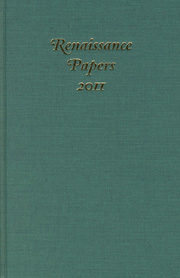Book contents
- Frontmatter
- Contents
- Dedication
- Walking, Waking, and the Armor of Light: Pauline Enactments in Henry IV, Part 1
- Costard's Revenge: Letters and Their Misdelivery in Love's Labour's Lost
- Productive Violence in Titus Andronicus
- Method in Marlowe's Massacre at Paris
- Ending Well: Mixed Genres and Audience Response in the London Theatrical Marketplace, 1604–06
- Birdlime: Sticky Entrapments in Renaissance Drama
- Sacrifice and Transcendence in Sir Philip Sidney's Astrophil and Stella
- The Quest for Certainty in Fulke Greville's A Treatie of Humane Learning
- Traces of the Masque in George Herbert's The Church
- Una Trinitas: Una and the Trinity in Book One of The Faerie Queene
- Reconsidering the 1599 Bishops' Ban on Satire
- Robert Bellarmine the Censor and Early-Modern Humanism
Birdlime: Sticky Entrapments in Renaissance Drama
Published online by Cambridge University Press: 05 April 2013
- Frontmatter
- Contents
- Dedication
- Walking, Waking, and the Armor of Light: Pauline Enactments in Henry IV, Part 1
- Costard's Revenge: Letters and Their Misdelivery in Love's Labour's Lost
- Productive Violence in Titus Andronicus
- Method in Marlowe's Massacre at Paris
- Ending Well: Mixed Genres and Audience Response in the London Theatrical Marketplace, 1604–06
- Birdlime: Sticky Entrapments in Renaissance Drama
- Sacrifice and Transcendence in Sir Philip Sidney's Astrophil and Stella
- The Quest for Certainty in Fulke Greville's A Treatie of Humane Learning
- Traces of the Masque in George Herbert's The Church
- Una Trinitas: Una and the Trinity in Book One of The Faerie Queene
- Reconsidering the 1599 Bishops' Ban on Satire
- Robert Bellarmine the Censor and Early-Modern Humanism
Summary
Eu'n as a bird that is with birdlime caught,
Doth beate her wings, and striues, and doth not cease
Vntill she hath her selfe all ouerwrought,
And quite intangled in the slimie grease. . . .
Renaissance theater held a mirror up to its audiences, reflecting the anxieties, emotions, and beauty of life, often in unsettling and challenging ways. Because theater served as a space for critiquing contemporary political, social, and religious structures as well as the personal challenges of life in this rapidly changing and often unstable society, much of the playwrights' subject material sprang from experiences of quotidian English life and landscape. Tapping into such shared daily experiences and natural phenomena provided cultural touch points that, as easily identified and widely understood metaphors, served to reinforce the sense of community in the audience and to propel catharsis and self-examination for individual spectators.
One such recurring image imported onto the stage from a common cultural vocabulary is the bird that has been trapped by alighting on a twig or string coated in sticky birdlime. Audiences were familiar with the picture of a bird caught by a hidden limed twig or string, crying and struggling to free itself, only to become more entangled in the sticky trap, sometimes to the point of ripping out its feathers.
- Type
- Chapter
- Information
- Renaissance Papers 2011 , pp. 65 - 78Publisher: Boydell & BrewerPrint publication year: 2012



